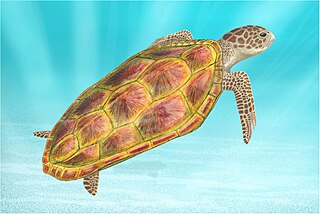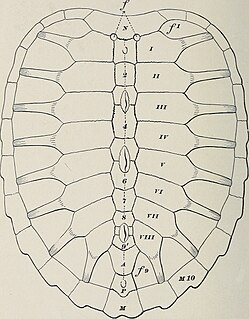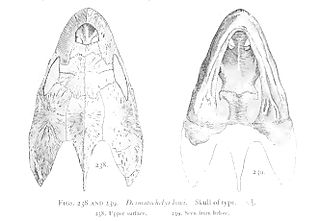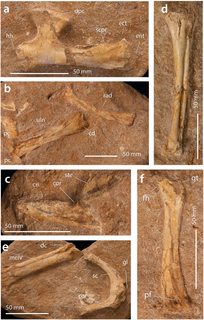
Archelon is an extinct marine turtle from the Late Cretaceous, and is the largest turtle ever to have been documented, with the biggest specimen measuring 460 cm (15 ft) from head to tail, 400 cm (13 ft) from flipper to flipper, and 2,200 kg (4,900 lb) in weight. It is known only from the Dakota Pierre Shale and has one species, A. ischyros. In the past, the genus also contained A. marshii and A. copei, though these have been reassigned to Protostega and Microstega, respectively. The genus was named in 1895 by American paleontologist George Reber Wieland based on a skeleton from South Dakota, who placed it into the extinct family Protostegidae. The leatherback sea turtle was once thought to be its closest living relative, but now, Protostegidae is thought to be a completely separate lineage from any living sea turtle.

Aralosaurus was a genus of hadrosaurid dinosaur that lived during the Late Cretaceous in what is now Kazakhstan. It is known only by a posterior half of a skull and some post-cranial bones found in the Bostobe Formation in rocks dated from the Upper Santonian-Lower Campanian boundary, at about 83.6 Ma. Only one species is known, Aralosaurus tuberiferus, described by Anatoly Konstantinovich Rozhdestvensky in 1968. The genus name means Aral Sea lizard, because it was found to the northeast of the Aral Sea. The specific epithet tuberiferus means bearing a tuber because the posterior part of the nasal bone rises sharply in front of the orbits like an outgrowth. Aralosaurus was originally reconstituted with a nasal arch similar to that of North American Kritosaurus. For many years, Aralosaurus was thus placed in the clade of the Hadrosaurinae. This classification was invalidated in 2004, following the re-examination of the skull of the animal which allowed to identify in Aralosaurus many typical characters of Lambeosaurinae. In particular, this study revealed that Aralosaurus had a hollow bony structure located far in front of the orbits, which communicated with the respiratory tract. This structure being broken at its base, its shape and size unfortunately remains undetermined. More recently, Aralosaurus has been identified as the most basal Lambeosaurinae, and placed with its close relative Canardia from the upper Maastrichtian of France in the new clade of Aralosaurini.

Protostega is an extinct genus of sea turtle containing a single species, Protostega gigas. Its fossil remains have been found in the Smoky Hill Chalk formation of western Kansas and time-equivalent beds of the Mooreville Chalk Formation of Alabama. Fossil specimens of this species were first collected in 1871, and named by Edward Drinker Cope in 1872. With a length of 3 metres (9.8 ft), it is the second-largest sea turtle that ever lived, second only to the giant Archelon, and the third-largest turtle of all time behind Archelon and Stupendemys.

Plesiopleurodon is an extinct genus of Mesozoic marine reptiles, belonging to Sauropterygia, known from the Late Cretaceous of North America. It was named by Kenneth Carpenter based on a complete skull with a mandible, cervical vertebra, and a coracoid. In naming the specimen, Carpenter noted "Of all known pliosaurs, Plesiopleurodon wellesi most closely resembles Liopleurodon ferox from the Oxfordian of Europe, hence the generic reference." It was initially described as a pliosaur due to it short neck, a common trait of the family, although it is in the order Plesiosauria. However, later exploration into the relationships of both orders indicate that not all pliosaurs have short necks and not all plesiosaurs have long necks.

Protostegidae is a family of extinct marine turtles that lived during the Cretaceous period. The family includes some of the largest sea turtles that ever existed. The largest, Archelon, had a head one metre (39 in) long. Like most sea turtles, they had flattened bodies and flippers for front appendages; protostegids had minimal shells like leatherback turtles of modern times.

Santanachelys gaffneyi is an extinct species of sea turtle. It is the only species in the genus Santanachelys, which itself is a member of the extinct family Protostegidae. The species was first described from a 20-centimeter long fossil specimen unearthed in 1998 from the Santana Formation of eastern Brazil. From the rock layer from which it was excavated, it was determined that the specimen was from the Early Cretaceous period. It is therefore one of the oldest known sea turtles. It was even recorded as the oldest sea turtle in Encyclopædia Britannica, but a new fossil named Desmatochelyspadillai in 2015 is estimated to be as old as 120 million years.
Hyposaurus is a genus of extinct marine dyrosaurid crocodyliform. Fossils have been found in Paleocene aged rocks of the Iullemmeden Basin in West Africa, Campanian–Maastrichtian Shendi Formation of Sudan and Maastrichtian through Danian strata in New Jersey, Alabama and South Carolina. Isolated teeth comparable to Hyposaurus have also been found in Thanetian strata of Virginia. It was related to Dyrosaurus. The priority of the species H. rogersii has been debated, however there is no sound basis for the recognition of more than one species from North America. The other North American species are therefore considered nomina vanum.
Corsochelys is an extinct genus of sea turtle that lived in the Late Cretaceous (Campanian). Zangerl (1960) named the type species, based upon remains found in Alabama within the Mooreville Chalk Formation.

Ctenochelys is an extinct genus of marine turtle, which existed during the Cretaceous period, and lived in the shallow waters of the Western Interior Seaway. Its fossils have been found in the Ripley Formation and Mooreville Chalk of central Alabama, United States. It was first named by C.H. Sternberg in 1904, and contains two species, C. stenoporus and C. acris.

Desmatochelys is an extinct genus of sea turtles belonging to the family Protostegidae. This genus contains two known species, D. lowii and D. padillai. D. lowii was first discovered in 1895, followed by D. padillai in 2015. Having been estimated at over 120 million years old, D. padillai is currently the oldest known species of sea turtle.

Chelosphargis is an extinct genus of sea turtle from Upper Cretaceous of Alabama. Only one species has been described, Chelosphargis advena.

Mesodermochelys is an extinct genus of sea turtle known from the Campanian to the Maastrichtian of what today is Japan. One species is known, the type species M. undulatus; it was given its binomial name by Ren Hirayama and Tsutomu Chitoku in 1996. Studies of its skull indicate that it was a primitive member of the Dermochelyidae that was closely related to the Protostegidae. It has been described as the best representative of Mesozoic dermochelyids.

Sphagesaurus is an extinct genus of sphagesaurid notosuchian crocodylomorph from the Late Cretaceous of southwest São Paulo, southern Brazil.
Caririemys is an extinct genus of side-necked turtles, belonging to the Pelomedusoides of the family Euraxemydidae. The type species is C. violetae. A single fossil of an individual was found in the Santana Formation in Brazil, an 80-million-year-old Late Cretaceous deposit that has so far preserved other fossil reptiles such as dinosaurs and crocodilians.
Gilmoremys is an extinct genus of softshell turtle which lived during the late Cretaceous of North Dakota, Montana and Wyoming, United States.

Ocepechelon is an extinct genus of giant protostegid sea turtle known from Late Cretaceous phosphatic deposits of the Oulad Abdoun Basin, Khouribga Province of Morocco. It is known from the holotype OCP DEK/GE 516, a complete but isolated 70-cm-long skull, making it one of the largest marine turtles ever described. It was first named by Nathalie Bardet, Nour-Eddine Jalil, France de Lapparent de Broin, Damien Germain, Olivier Lambert and Mbarek Amaghzaz in 2013 and the type species is Ocepechelon bouyai. The feeding apparatus of Ocepechelon, a bony pipette-like snout, is unique among tetrapods and shares unique convergences with both syngnathid fishes and beaked whales.

Desmatochelys padillai is an extinct species of sea turtle described in 2015 and belongs to the family Protostegidae. Estimated to be more than 120 millions years old, it became the oldest known sea turtle, superseding a record earlier held by Santanachelys gaffneyi, which was described in 1998. The fossil, including bones and shells, was discovered from Villa de Leyva in Colombia in 2007. The specimen is larger than an average-sized human, measuring 2 m in length, and exhibits the key features of modern sea turtles. The specific name is given in honour of Carlos Bernardo Padilla, a renowned supporter of the palaeontology of the region.

Basilemys is a large, terrestrial trionychoid turtle that was from the Upper Cretaceous time period. In Greek, the "Basil (name)" means royal or kingly and the word "Emys" means turtle. Therefore, Basilemys means King Turtle. The stratigraphic subdivisions of the Upper Cretaceous include Cenomanian, Turonian, Coniacian, Santonian, Campanian, and Maastrichtian. Basilemys was mostly from the Campanian and Maastrichtian subdivisions of the Cretaceous time period and is considered to be the largest terrestrial turtle of its time. This extinct genus of land turtles belongs to the family Nanhsiungchelyidae. Occurrences of Basilemys have largely been reported in the North America region. The family Nanhsiungchelyidae made its first appearance in the Lower Cretaceous in Asia and we know from Basilemys that this family appeared in the Upper Cretaceous in North America. The North American populations of Basilemys are considered to be immigrants from Asia through the Beringia during the Upper Cretaceous. In an analysis made by Sukhanov et al. on a new Nansiunghelyid turtle from the Upper Cretaceous of Mongolia, it was demonstrated that Asian nanhsiungchelyids gave rise to the North American nanhsiungchelyids. One genus from the family Nanhsiungchelyidae, Zangerlia, is similar to Basilemys in terms of skull proportions. However, Basilemys has a more complex triturating surface that includes well-defined pockets on the dentary. Basilemys also has tooth-like projections on the triturating surface of the maxilla.

Leyvachelys is an extinct genus of turtles in the family Sandownidae from the Early Cretaceous of the present-day Altiplano Cundiboyacense, Eastern Ranges, Colombian Andes. The genus is known only from its type species, Leyvachelys cipadi, described in 2015 by Colombian paleontologist Edwin Cadena. Fossils of Leyvachelys have been found in the fossiliferous Paja Formation, close to Villa de Leyva, Boyacá, after which the genus is named. The holotype specimen is the oldest and most complete sandownid turtle found to date.

Alcione is a genus nyctosaurid pterosaur from the Ouled Abdoun Basin of Morocco, dating back to the Maastrichtian stage of the Late Cretaceous period. Only one species, A. elainus, is known. This pterosaur lived in a marine environment alongside several other pterosaurs, including the nyctosaurids Simurghia and Barbaridactylus.















